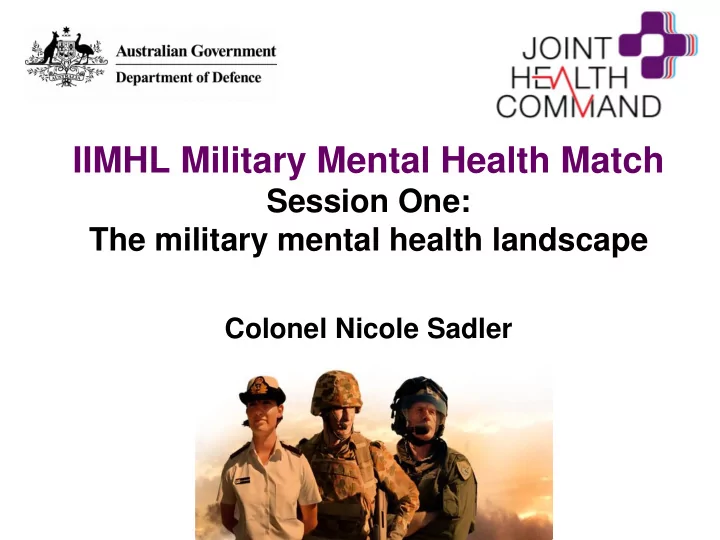

IIMHL Military Mental Health Match Session One: The military mental health landscape Colonel Nicole Sadler
ADF Mental Health Reform • 2002 ADF Mental Health Strategy • 2009 Dunt Review • Four year ADF Mental Health Reform program • 2010 ADF Mental Health Prevalence and Wellbeing Study • 2011 ADF Mental Health and Wellbeing Strategy • ADF Mental Health and Wellbeing Action Plan (2012-2015)
Military Health Outcomes Program (MILHOP) 2010 AD ADF Menta tal He l Health lth Pr Prevalenc valence e an and d Wellbeing ellbeing Stud Study MEAO Census Study Reserve & ex- Health ealth and W and Wellbeing ellbeing Sur urvey ey serving members Regular currently Regular, currently serving Regular serving members, members who members deployed to MEAO in responded after Not deployed to MEAO 2001-2009, surveyed in 2010 before 2010 2010-2011 Deployed to MEAO 2001- N=24481 N = 14961 N = 9520 2009 N=14032 48.9% N = 4512 53.5% MEA EAO O Pr Prospe ospectiv ctive Stud e Study • Selected units deployed June 2010-June 2012 • Measured before & after deployment N=1325 (pre and post surveys: 43.1%)
Mental Health in the ADF • 12 month mental health disorder rates in the ADF were similar to an age, sex and employment matched Australian community sample with one in five ADF members having experienced a disorder • Over half of the ADF had experienced an anxiety, affective or alcohol disorder at some stage in their lifetime, which is significantly higher than the matched community sample
Mental Health in the ADF • ADF members who do not deploy are equally at risk of developing mental disorders as those who deploy • Not all personnel deployed will be exposed to trauma • Higher prevalence of all disorder categories in Other Ranks • High prevalence of first trauma exposures prior to entry • Exposure to trauma through deployment, as well as lifetime history of trauma, can increase the risk of mental disorder • Interpersonal (female) and accident/other unexpected traumas (male) associated with PTSD and depression • Transitioning and ex-serving members require greater attention • PTSD is important – but it is not the only mental disorder of concern
2011 ADF Mental Health and Wellbeing Strategy - Six Strategic Objectives 1. Promote and support mental fitness within the ADF 2. Identification and response to mental health risks of military service 3. Delivery of comprehensive, coordinated, customised mental health care 4. Continuously improve the quality of mental health care 5. Building an evidence base about military mental health and wellbeing 6. Strengthening strategic partnerships and strategic development http://www.defence.gov.au/health/DMH/i-MHRP.htm
ADF Military Occupational Mental Health and Wellbeing Model
Underlying Principles • Not just about mental disorders - also about wellbeing • Military service has unique risk factors – But it’s not all about deployment • Most people cope well and are resilient • Everyone has a role, including commanders, peers and families • Need a continuum approach that considers all stages of a career – Including transition • Defence provides treatment, no matter the cause of the mental health problem or mental disorder • Early intervention is important – Need to address stigmas and barriers to care • Evidence-based treatment from a skilled workforce • Close collaboration required between all service providers – Internal and external to Defence
Recommend
More recommend